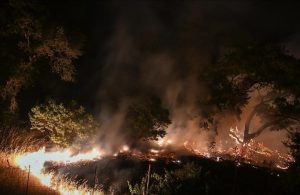Russia launches huge attack on Ukraine’s energy infrastructure
3 min readRussia has launched a massive assault on Ukraine’s energy infrastructure, marking the 12th large-scale attack on energy facilities this year. Ukrainian officials reported that the attack involved 93 missiles and over 200 drones, though 81 missiles were intercepted, according to President Volodymyr Zelensky. The strikes primarily targeted western Ukraine, with significant damage to energy facilities across several regions. Authorities in Ivano-Frankivsk called it the worst attack the region has faced to date.
Moscow has justified the attack, claiming it was a response to a Ukrainian strike on a military airbase in southwestern Russia, which involved US-made missiles. In an interview with Time magazine, US President-elect Donald Trump expressed strong disagreement with the use of American missiles on Russian sites, calling it “crazy” and warning that it would only escalate the conflict. “We’re just escalating this war and making it worse,” Trump remarked.
The Kremlin responded by stating that Trump’s comments were in line with Moscow’s position, with spokesman Dmitry Peskov praising Trump’s understanding of the situation. “It is obvious that Trump understands exactly what is escalating the situation,” Peskov told reporters. Trump also mentioned his desire to negotiate an end to the war, suggesting that the only way forward was to avoid abandonment of peace talks. This came after US President Joe Biden authorized Ukraine to use ATACMS missiles, which Ukraine began deploying in October 2023 against Russian targets in occupied Ukrainian territories. The first use of these long-range missiles occurred the day after Biden’s approval, with Russia confirming the missile strikes on the Bryansk region, which borders Ukraine.
The Russian missile strikes took place on one of the coldest days of the Ukrainian winter, with temperatures plunging to -6°C (21°F). The energy and infrastructure facilities in Ivano-Frankivsk were among the hardest hit, while Lviv and Ternopil also suffered damage. In the Kyiv region, however, critical and residential infrastructure remained largely untouched, according to local authorities. Despite this, the broader impact was significant. Five of Ukraine’s nine nuclear reactor units were forced to operate at reduced capacity due to the damage caused by the strikes.
In response to the damage, Ukraine’s national energy company, Ukrenergo, implemented power supply restrictions on Friday. The restrictions resulted in rolling blackouts across all regions of the country. To manage the power shortage, Ukraine also began importing electricity from neighboring countries, including Poland, Romania, Slovakia, Hungary, and Moldova. This strategy aimed to mitigate the impact of the attack on the nation’s energy supply.
This attack is part of the broader context of Russia’s ongoing invasion of Ukraine, which began in February 2022. Since the onset of the war, Russia has made territorial gains and losses. As of the latest reports, Russian forces have captured and retaken approximately 2,350 square kilometers (907 square miles) of territory in eastern Ukraine and the western Kursk region of Russia. Despite these territorial changes, the war continues with significant human, military, and economic consequences for both nations.
The timing of Russia’s strikes, amidst the harsh winter conditions, is seen as part of a broader strategy to cripple Ukraine’s energy infrastructure and put additional pressure on the Ukrainian government and civilians. These attacks are not only a military tactic but also a means of targeting Ukraine’s ability to function during a critical period when energy demands are at their highest.
In summary, the latest Russian attack on Ukraine’s energy grid has caused significant damage, particularly in the western regions, and led to widespread power outages. The missile and drone assault has further strained Ukraine’s energy resources, especially during the coldest days of winter. Meanwhile, international involvement continues to shape the course of the war, with leaders like Donald Trump voicing concerns over escalating tensions, while Ukraine’s continued use of US-supplied weapons adds another layer of complexity to the conflict. As the war rages on, the humanitarian and infrastructural impacts remain profound, and efforts to bring the conflict to an end have not yet been realized.





